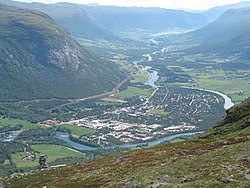Skjåk Municipality
| Skjåk kommune | |||
|---|---|---|---|
| Municipality | |||
 |
|||
|
|||
 Skjåk within Oppland |
|||
| Coordinates: 61°56′10″N 7°57′37″E / 61.93611°N 7.96028°ECoordinates: 61°56′10″N 7°57′37″E / 61.93611°N 7.96028°E | |||
| Country | Norway | ||
| County | Oppland | ||
| District | Gudbrandsdalen | ||
| Administrative centre | Bismo | ||
| Government | |||
| • Mayor (2015) | Elias Sperstad (Sp) | ||
| Area | |||
| • Total | 2,076 km2 (802 sq mi) | ||
| • Land | 1,969 km2 (760 sq mi) | ||
| Area rank | 27 in Norway | ||
| Population (2004) | |||
| • Total | 2,393 | ||
| • Rank | 311 in Norway | ||
| • Density | 1/km2 (3/sq mi) | ||
| • Change (10 years) | -5.3 % | ||
| Demonym(s) | Skjåkvær | ||
| Time zone | CET (UTC+1) | ||
| • Summer (DST) | CEST (UTC+2) | ||
| ISO 3166 code | NO-0513 | ||
| Official language form | Nynorsk | ||
| Website | www |
||
|
|
|||
Skjåk is a municipality in Oppland county, Norway. It is part of the traditional region of Gudbrandsdalen. The administrative centre of the municipality is the village of Bismo. The municipality of Skjåk was created when it was separated from Lom to become a municipality of its own in 1866.
The local newspaper is named Fjuken.
The municipality (originally the parish) is named after the old Skjåk farm (Old Norse: Skeiðakr), since the first church was built here. The first element is skeið which means "a running track for horse racing" and the last element is akr which means "field" or "acre".
Prior to 1889, the name was written "Skiaker", then from 1889-1910 it was spelled "Skiaaker", from 1911-1920 it was "Skjaak", and since 1921 it has been written in its present form, "Skjåk".
The coat-of-arms is from modern times. They were granted on 31 March 1989. It shows four silver-colored acanthus leaves on a blue background. This was picked to symbolize growth and strength. These symbols are found in many historic artifacts from around the area.
Skjåk has historical roots back to the Viking Age and has a rich cultural heritage. An ancient route of travel between east and west went from Skjåk up through the Raudal valley and down through the Sunndal valley to Stryn on an arm of the Nordfjord. For example, in 1197, according to King Sverre's saga, Bishop Nikolaus is reported to have sent a group of baglers from Oppdal over the mountains to Stryn on Nordfjord, via Raudal.
...
Wikipedia


